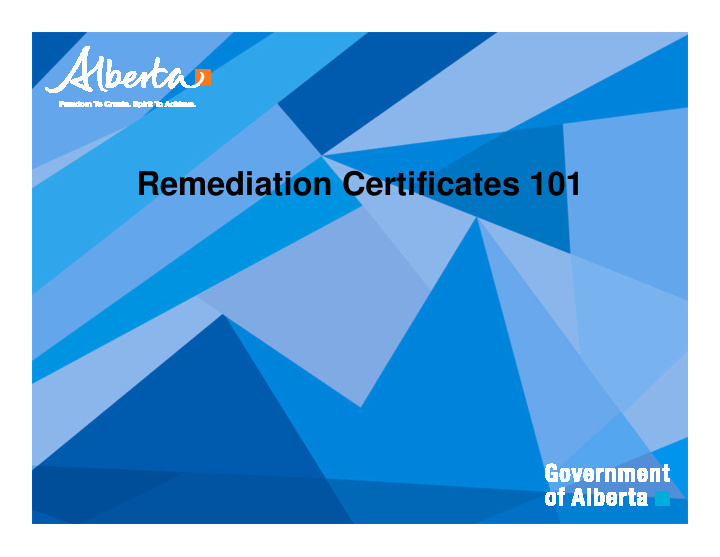



Remediation Certificates 101
Outline • What are they? – Regulatory basis for issuing remediation certificates – Definitions and brief history of the program • Why should I want one? – Benefits for the site owner – Benefits for the public at large – Benefits for regulators • How do I get one? – Site eligibility requirements – Application process • The future of the program
What are they? A brief history
What are they? Regulatory basis for the program • Regulatory Basis – For sites under part 5 of the Environmental Protection and Enhancement Act – Regulatory scope of certificates is defined via the Remediation Certificate Regulation • Voluntary certificate program • Commenced June 2009 for petroleum storage tank sites. This was recently replaced with two programs: – The first program is for general contaminated sites. – The second program is for upstream oil and gas sites
What are they? Scope and authority • Authority/limits of a remediation certificate – Certificates are issued on a release basis – Once a certificate is issued, environmental liability is discharged for that release • Audits verify the effectiveness of the program – 10% of sites to be audited – Intrusive audit program similar to the subsurface audits for the Reclamation Certificate program
Why should I want one? Benefits for stakeholders
Why should I want one? Reclamation vs. Remediation • Reclamation: – Returning disturbed land to equivalent capability – Focus on land surface – Required for specified land – Surface liability remains for 25 years after certification for surface – No liability closure for subsurface contamination • Remediation: – Reducing contaminant levels to concentrations below environmental risk – Focus on subsurface soil and groundwater – Liability release for subsurface contamination upon certification
Why should I want one? Benefits for site owners • Provides certainty for proponent if standards change • Provides closure of liability upon certification • Displays willingness of the site owner to clean sites up completely and with transparency
Why should I want one? Benefits to the public at large • Incentive to remediate – e.g., Redevelopment of vacant properties in the urban core • Provides assurance that appropriate remedial measures were employed – Data and information required for application is well-defined – Provides requirements for assessment and remediation • Formalizes risk management of offsite contamination – The certificate is issued contingent on operation of the risk management plan
Why should I want one? Benefits to regulators • Incentive to remediate – Brownfield vs. Greenfield redevelopment – Thousands of abandoned and suspended well sites with no regulatory mechanism to drive formal closure • Provides a way to assure the public that appropriate remedial measures were employed • Allows for future tracking of remediation statistics
How do I get one?
How do I get one? Remediation Certificate eligibility • On-site Spill – Entirely remediated • On-site Spill extending Offsite – Remediate on-site contamination – Remediate or risk manage off-site areas • Off-site Remediation – Must include exposure control to protect from on-site impacts
How do I get one? Application Process • Remediation Certificate application submitted to the regulatory approvals centre • Administrative review is done to ensure all of the required information has been submitted • Application is given a technical review to ensure technical sufficiency • Certificate is issued or refused
How do I get one? Application information required • Substance release information • Area and depth of contamination • Offsite information • Receptors and pathways – Water wells, surface water bodies, adjacent residences. • Remediation land use criteria used – Current and future zoning • Remediation process • Remediation criteria used – Tier 1 or Tier 2
How do I get one? Application information required • Survey plan of the site with remediated area • Map with location of remediated area • Cross – section of top and base of remediation • Land title certificate • Phase 1 ESA, Phase 2 ESA reports that haven’t been submitted • Borehole logs • Lab analytical data • Risk management plan & Third Party Risk Management Plan Agreement • $1000 Fee
How do I get one? Professional signoff requirements • Applicant Declaration • Professional Declaration: sign off required – Seven professional regulatory organization • ACPA, AIA, APEGGA, ASET, ASPB, CAPF, CAPFT – Minimum of 5 years verifiable experience in remediation relative to the Competency Tables – Carry errors and omissions insurance coverage
How do I get one? Avoid these common issues • Not signed by a professional – Must be stamped or membership number must be included • No cross – sections of the remediated zones • Insufficient or improper remediation excavation samples • Backfill soil quality analyses not included • Improper application of Tier 2 and/or salinity guidelines
Questions? Contact Alberta Environment and Water’s Information Centre (780) 427 2700
Recommend
More recommend